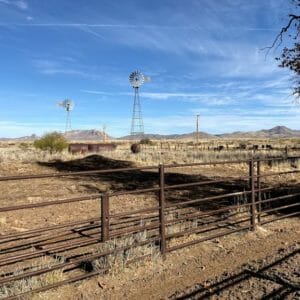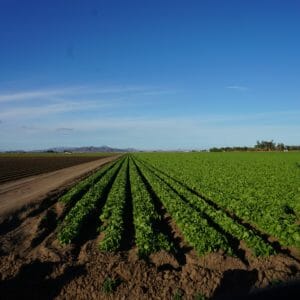Our students were surprised to learn that the Phoenix metro area uses less water than it did in 1987. That’s because there’s lots of hard work going on to make water use more efficient, including at the ASU Decision Center for a Desert City where Ray Quay works.
This blog post was written by Arizona State University graduate student Emma Rotner. In addition to studying Food Policy and Sustainability Leadership at ASU, Emma is a the Farm to School coordinator for Groton Public Schools, where she works to connect kids to their local food systems through a variety of hands on lessons.
It would be effectively impossible to visit Arizona, especially Arizona farms and ranches, without some mention of water (or perhaps the lack thereof). So naturally, water was an overarching theme throughout our ASU Food Policy and Sustainability Leadership cohort trip to Arizona in December of last year. While farming in the desert presents a whole host of unique challenges, water is typically at or very near the epicenter for most situations.
On our second day in Arizona, we dove right into the water debate with a lecture from Ray Quay, a researcher with the Decision Center for a Desert City in the Julie Ann Wrigley Global Institute of Sustainability at ASU, who’s work revolves around water. Quay’s research and work seeks to understand and address the challenges of water availability and allotments particularly as they pertain to competing agricultural and urban interests. During his lecture, Quay shared with us some of the center’s modelling work that demonstrates the complex relationships between energy, food, and water. At ASU, Quay and others are using these models to investigate different strategies to create a more sustainable and efficient system for all water users.
Of interest to agriculture, Quay’s models account for possible water contingency plans in the case of serious droughts. These plans consider the effect of changes in various water inputs from groundwater to mountain runoff and how they relate to Arizona’s two major water outputs: agricultural systems and municipal use. Since agriculture is a huge part of Arizona’s economy, models such as these are necessary to understand and inform policy and to improve existing systems especially at times when difficult trade-offs may need to be made.
We then saw this first-hand driving through Arizona, following miles of dry, arid land, interrupted in places by starkly contrasting dark green agricultural fields. We heard from countless farmers about the large quantities of water required for their fields and the weekly process of ordering and distributing water for irrigation. Seeing these models prior to visiting so many different farmers across Arizona provided an invaluable background and understanding of the challenges that Arizona farmers currently face with water usage and the challenges they are likely to endure with the progression of climate change. Between Quay’s modelling and our farm visits it was crystal clear how crucial water rights and contingency plans are to ensure the continued vitality of the region.
As we navigate these uncertain times it is more important than ever to have a robust network of food and agriculture policy leaders to make sensible and responsible decisions. Could you be one of those people? Learn more about answering this call by checking out the Food Policy and Sustainability Leadership Program at ASU!


